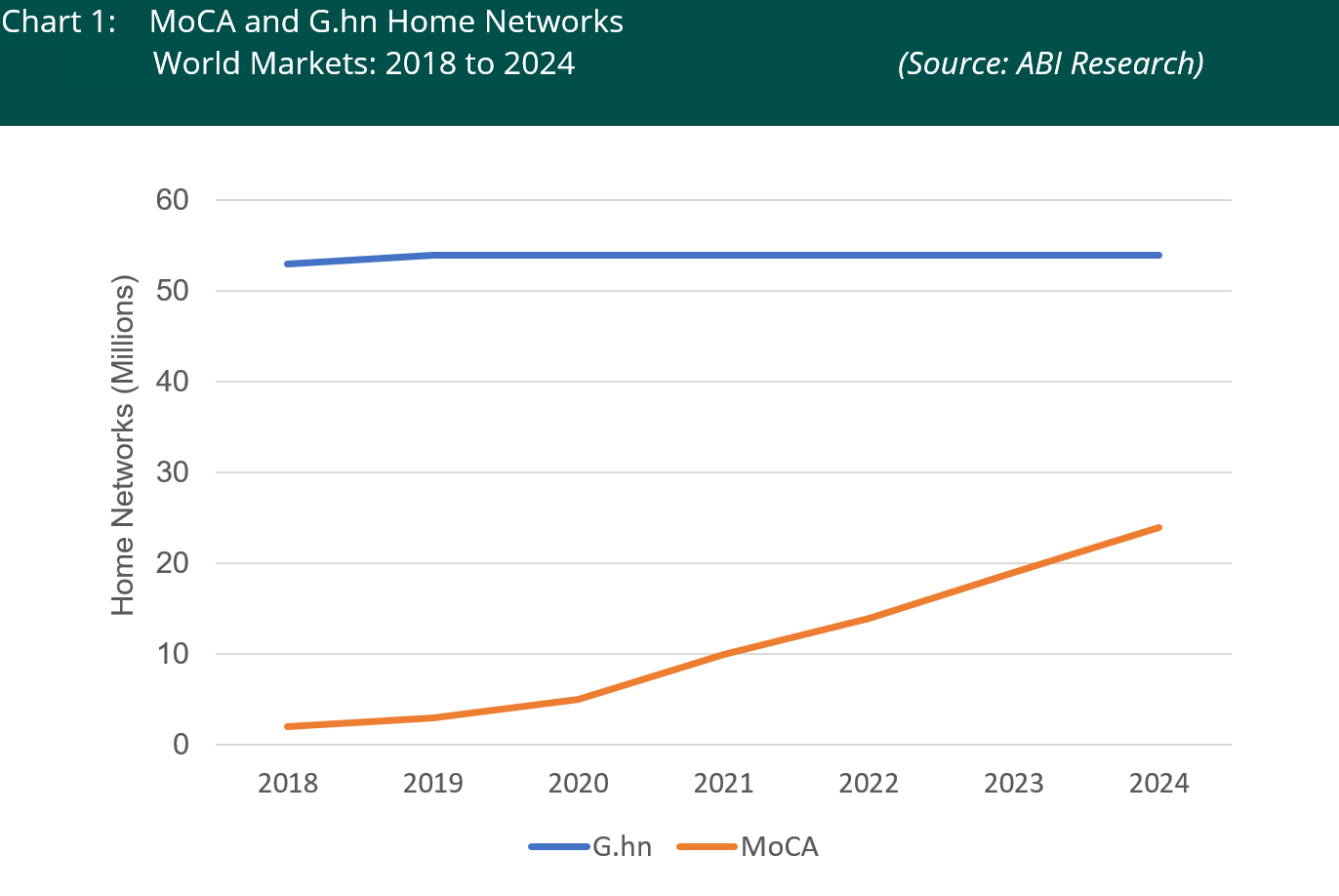With smart home applications becoming ever-more popular, and with households making heavy use of streaming multimedia services, the growing demand for reliable, high-capacity home networking technology shows no sign of slowing down. As a result, Wi-Fi, which has been the dominant player in the home network market for years, may be facing some competition from two wired networks: G.hn and Multimedia over Coax Alliance (MoCA) 2.5.
According to our home networking market data report, MoCA 2.5 and G.hn are gaining in popularity as consumers look for devices with higher throughput to handle all of the increased activity within their homes, especially as remote work has become more prevalent.
Wi-Fi Is Not for Everyone
Wi-Fi routers were first introduced in the early 2000s, and they soon replaced Ethernet cables as the dominant technology thanks to their ability to connect multiple devices without the need to run wires or puncture walls. Since that time, newer Wi-Fi standards and devices – such as Wi-Fi mesh systems–have been introduced, improving the coverage and throughput of home networks.
However, wired connectivity can provide superior stability and throughput, especially while using bandwidth-intensive applications. This is where technologies like G.hn and MoCA can differentiate themselves.
What is G.hn Technology?
Gigabit Home Networking (G.hn) is a wired home networking specification that was formed by the UN’s ITU-T standardization body and supports speeds of up to 2 Gbs/s. Not only does G.hn technology provide end users with ultra-fast and reliable network connectivity, but it can also be installed anywhere there is existing network wiring already installed. G.hn can be operated over physical connections like coaxial cables, telephone wires, power lines, and plastic optical fiber.
In a recent press release, German developer Teleconnect has shown that G.hn may have a pivotal role to play in the emergence of 5G.
What is MoCA?
Multimedia Over Coax Alliance (MoCA) is an alternative to a mesh Wi-Fi network, which can sometimes be unreliable. Just like G.hn technology, MoCA can use the wired connection that already exists in a home via coaxial cable. Often, MoCA is used in tandem with Wi-Fi as it frees up network resources and can provide faster and more stable speeds than standalone Wi-Fi.
Why wouldn't someone just use ethernet? Well, there are many cases where ethernet LAN just isn't possible. For example, if someone wants a wired connection to a gaming console but the Wi-Fi router is in the basement, ethernet is out of the question. MoCa on the other hand can be installed in any room that has a wired connection outlet, opening up new possibilities.
MoCA 2.0 Versus MoCA 2.5
MoCA 2.5 is simply the upgraded version of MoCA 2.0. Whereas MoCA 2.5 supports speeds of up to 2.5 Gbps, MoCA 2.0 only supports 500 Mbps. While MoCA 2.0 brought great upgrades at the time, MoCA 2.5 is superior. MoCA 2.5 brings a more reliable connection (less than 5ms latency) and advanced security features to keep users' minds at ease. Both MoCA 2.0 and MoCA 2.5 are backward compatible. However, the connection will be limited to the maximum speed the legacy protocol is capable of. For example, a MoCA 2.5 adapter communicating with a MoCA 1.1 device would only reach 175 Mbps.
Something to be mindful of is that MoCA 3.0 is right around the corner, which will arrive in 2022/2023, and supports an amazing speed of 10 Gbs/s.
What’s The Impact of G.hn and MoCA On ISPs?
There is growing interest from service providers in both technologies to deploy as an efficient backbone for residential Wi-Fi networks. Chunghwa Telecom, a Taiwanese service provider, recently announced the launch of Gh.n adapters to its FTTx subscribers. Operators including China Telecom, China Unicom, and UK Liberty Global have also joined the HomeGrid Forum in support of G.hn technology.
MoCA home networking adoption is mainly concentrated in North America. However, the Multimedia over Coax Alliance continues to eye growth in Europe and the Asia Pacific, particularly since 2017 with the introduction of MoCA Access 2.5 which added broadband access specifications based on MoCA 2.5. Companies around the globe, including InCoax (Sweden), Teamly Digital (France), and ZTE have all recently announced MoCA Access 2.5 solutions. One of the premier ISPs in the world, Verizon, offers MoCA 2.5 ethernet adapters to its residential customers.
Chipset vendors like MaxLinear, Marvell, and Xingtera play a key role in enabling G.hn capabilities for ISP products.
Complementary Technologies to G.hn and MoCA
Wi-Fi is certainly the preferred home network connectivity, however, there is significant market potential for wired networking devices supporting high capacity or complementing Wi-Fi installations. The increasing use of live video streaming, remote work in a post-COVID world, gaming, and VR applications is likely to boost demand for 100% reliable coverage of home networks. Dish Network, which had already supported MoCA, recently announced its commitment to G.hn support. In turn, this will allow the company to resonate with consumers with varying technologies.
Service providers can take advantage of advanced home networking devices like MoCA and G.hn and integrate them with Wi-Fi offerings to optimize the customer experience. More than ever, people have work-from-home arrangements that put hefty bandwidth demands that traditional Wi-Fi solutions may struggle to manage. Furthermore, the gaming industry only continues to grow at a rapid pace, placing more demand on a reliable connection that won't hinder online gameplay.
Market Data for G.hn and MoCA
Outside of North America, MoCA deployments are rare. Indeed, North America accounts for nearly 50 million of the 54 million total MoCA deployments worldwide. Even then, growth is dead in North America as the number of MoCA deployments has been hovering around the 50 million mark since 2018.
For G.hn home networks, the story is quite different. Growing at a CAGR of 44% between 2020 and 2024, there will be 24 million G.hn home networks by 2024 worldwide, with Western Europe and Asia-Pacific comprising almost the entire market.
Western Europe is the biggest adopter of G.hn, with 11.32 million network installations projected for 2024. Asia-Pacific, which accounts for more than half of the world's 1 billion home Wi-Fi networks, will have just over 6 million G.hn home networks in 2024.
As it stands, advanced home networks are a small niche in a market dominated by traditional Wi-Fi solutions that ISPs can consumers are comfortable with. For example, the home network penetration rate for Wi-Fi will reach 49.3% by 2024, whereas MoCA and G.hn will be just 2.5% and 1.1%, respectively.
The chart below shows the growth trends with MoCA and G.hn home networks between 2018 and 2024.

To stay on top of the latest home networking developments, trends, and market opportunities, check out our Smart Homes & Buildings Research Service.


